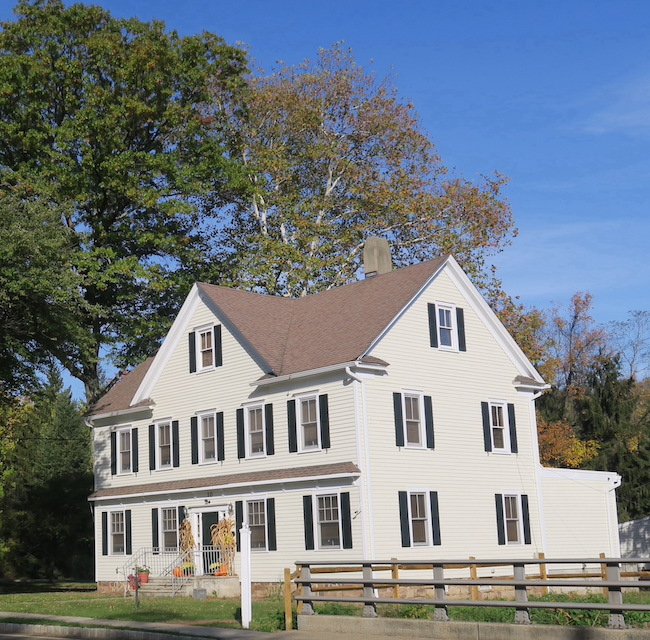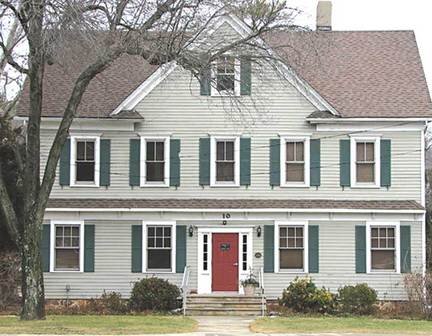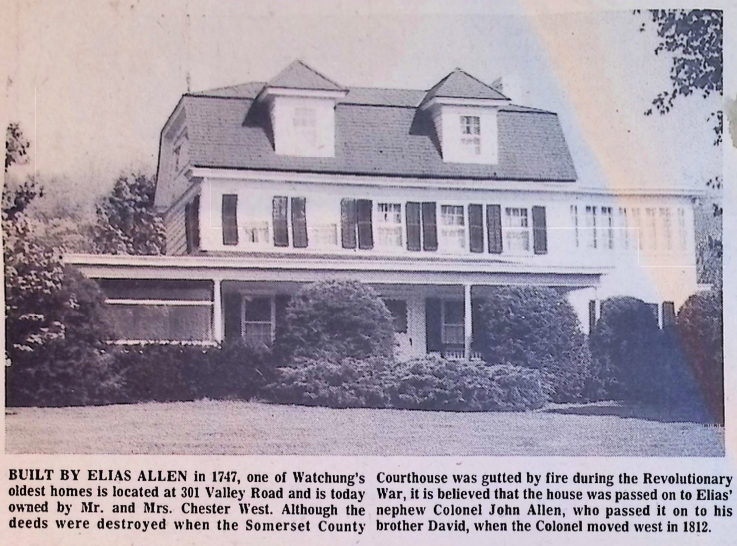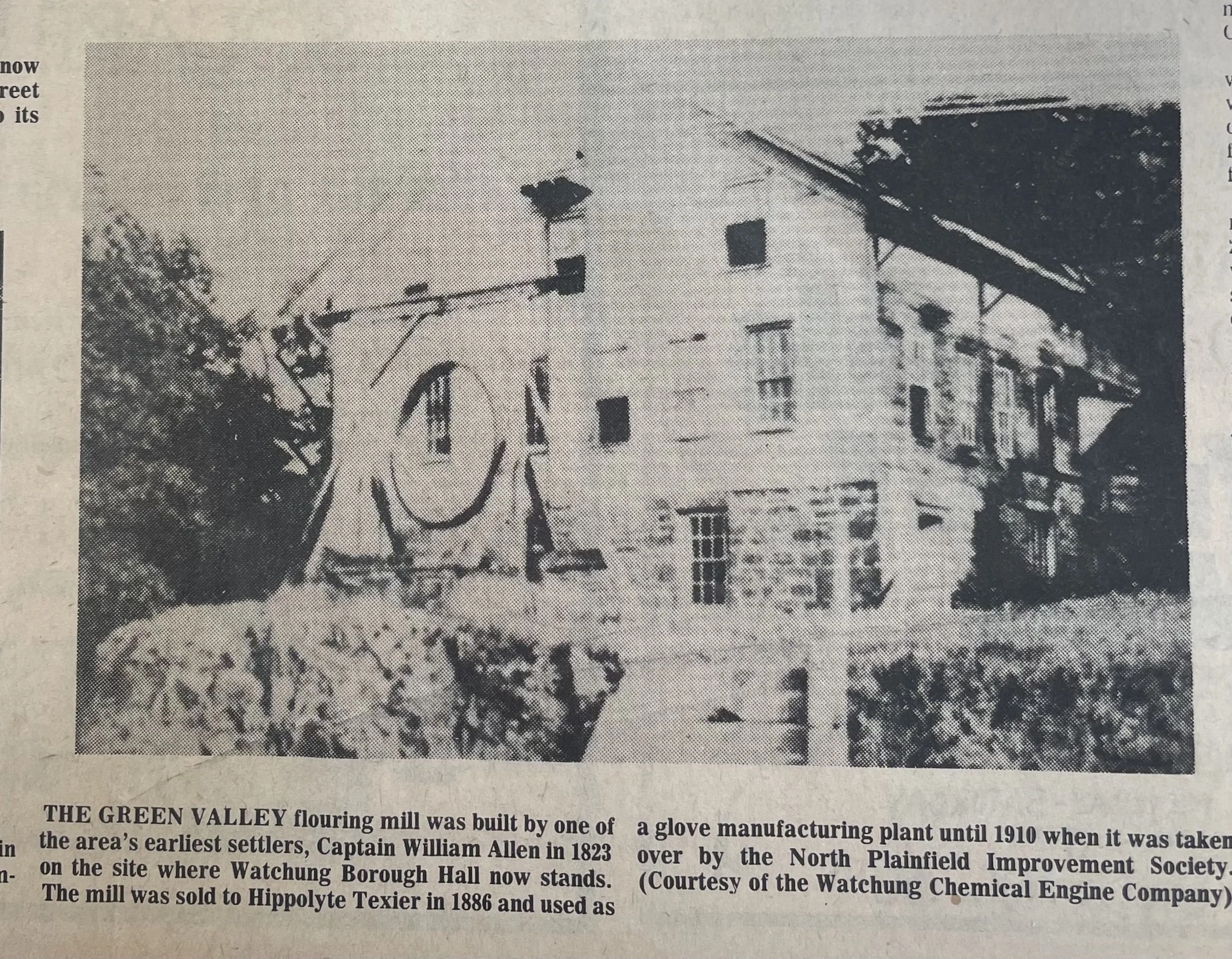A Look Back Into The History Of the Watchung Hills
When Watchung was Browestown
BUILT BY ELIAS ALLEN in 1747, one of Watchung’s oldest homes is located at 301 Valley Road and is today owned by Mr. And Mrs. Chester West. Although the deeds were destroyed when the Somerset County Courthouse was gutted by fire during the Revolutionary war, it is believed that the house was. Passed on to Elias’ nephew Colonel John Allen, who passed it on to his brother David, when the Colonel moved west in 1812.
STILL EQUIPPED WITHL the utensils which were in colonial davs, the original fireplace with its bake oven is a fascinating feature of the A.H. Santucel's 275 year old home on Mountain Boulevard in Watchung, Another fireplace that is still intact in the basement and it is believed that it was used asa cooking facility for slaves.
DAVID STEWART TAVERN, later known as Demler’s Hotel and most recently as the Washington House, was a popular inn along the Colonial Stagecoach Route. Built in 1738, it stood on Somerset Street across from the Stoney Brook until it was destroyed by fire in1963. (Courtesy of the Watchung Chemical Engine Company)
THE GREEN VALLEY flouring mill was built by one of the area's earliest settlers, Captain William Allen in 1823 on the site where Watchung Borough Hall now stands.
The mill was sold to Hippolyte Texier in 1886 and used as a glove manufacturing plant until 1910 when it was taken over by the North Plainfield Improvement Society (Courtesy of the Watchung Chemical Engine Company)
COAL MINING WAS once a profitable enterprise in the Watchung Hills. Several mines were located in Warren and one was located about a quarter-mile from the Watchung traffic circle on Valley Road. Here miners load stone onto wagons manually at a mining site along New Providence Road. (Courtesy Watchung Chemical Engine Company)
By CHARLES HONART
In the hectic hustle and bustle of life in the Watchung Hills, it is difficult to sit back and imagine what life was like in the northeast corner of Somerset County 200 years ago.
Most of the houses are new now and the stores and schools are modern. Residents work miles from their homes and many commute daily to offices long distances away.
And yet within this contemporary landscape, remnants of the past still remain. Much of the area retains its original rural character and farms still abound. In addition, some of the original dwellings, refurbished a bit, still stand near where they stood two centuries ago. Finally, old manuscripts, maps and deeds are still available in the archives of area libraries and tell of lifestyles and surrounding quite unlike those which greet us today.
The first part reprints a fictitious letter, written here by a Trenton entrepreneur, John S. Badgley, to a business associate. Badgley has travelled to Watchung where he hopes to purchase a home and a copper mine.
Although Badgley is a ficticious character, the people he speaks of and the area they inhabit are much as they were in the early 1800’s.
It is the summer of 1825. Watchung is known as Browestown and is part of Warren Township, which had been formed from Bernards Township 19 years before.
Badgley is writing from a room at the old Washington House which stood on Somerset Street until it was gutted by fire in 1963.
The inn, which had been built in 1738, was owned by David Stewart at the time and was located along the Colonial Stagecoach route which ran from Trenton to Morristown. George Washington was reputed to have stopped there during the Revolutionary War.
The Green Valley Flouring Mill, to which Badgley refers, was located where Borough Hall stands today, while the General Store stood across the street near the present Rescue Squad building.
The mill was built in 1823 by Captain William Allen, who operated it until 1860, when it was sold to Moses French. The building was destroyed by fire in 1870. It was rebuilt and sold in 1886 to Hippolyte Texier who used it as a glove factory. It was torn down in 1928.
The two homes which are mentioned in the Badgley letter are among the 10 pre-Revolutionary War houses which still stand in the borough today.
David Allen’s home is presently owned by Chester D. West and is located at 301 Valley Road. The house still retains its original brick walls and banister. The original fireplace is still intact, as are the hand-blown glass windows. In the basement the original beams are still exposed.
The house was moved back from the road in 1920, at which time a new kitchen was added. The mansard roof was put on in the late 1800’s.
Remnants of the copper mine are located on the Eaton property adjacent to the West’s home.
The second house mentioned by Badgley is located on Mountain Boulevard in the wooded area behind O’Connor’s Beef and Ale House and belongs to A.H. Santucci.
The Santucci house has also retained many of its original features. The living room fireplace, equipped with an old charcoal iron, a foot warmer, antique cooking pots, and a bake oven built to one side, has been maintained, as have the original walls constructed of pine needles, horsehair, straw and clay.
The original floors have been preserved as has the old well which stands in front of the house.
There is also a fireplace in the basement, which may have been used as a cooking facility for slaves at one time.
The Tituses owned the home in the early 1800’s. Hippolyte Texier lived there later and started his glove manufacturing in the old barn which once stood on the property.
The letter was pieced together with the help of the Wests and the Santuccis’, as well as James Snell’s History of Somerset and Hunterdon County and Thomas F. Gorg- don’s 1834 Gazetteer of the State of New Jersey.
Thursday, August 4, 1825 Dear Ephriam,
We are within a days reach of Morristown now and if the weather permits, we will be there by early tomorrow afternoon.
The Colonial stagecoach left Trenton this morning about 10 a.m. and travelled northwestward at a very slow pace due to the persistent log and drizzle.
We arrived here in Warren Township at about 5 pan. and I will spend the evening here at David Stewart's Tavern in Browestown, which is a quaint little place along the Stony Brook, not far from the Green Valley Flouring Mill.
If the weather breaks a bit, 1 hope to meet al the homestead of Mr. David Allen after supper in order to survey the properly in which 1 am interested, located between the first and second mountains along the valley road.
In the morning, prior to my departure for Morristown, I will also survey the Titus property which is located on the Uld Star Road about a mile and half from Browestown center.
In the event that the Allen properly is either unavailable or not suitable, 1 would consider purchasing this tract in hope of erecting a cider mill east of the site.
The Titus property is very convenient to Quibbletown and points south, which can be reached py (he old Gup Hoad which passes over the top of the mountain near the Titus home.
Browestown is officially part of Warren and is located at the township’s extreme eastern end. According to the 1820 census there are 1452 residents here, most of whom are involved in agriculture, including stock and grain raising and dairying.
The terrain is quite hilly and is well-wooded. Behind the tavern, the mountain rises vertically to an elevation of over 500 feel and similarly sized hills lie at the northern end of the valley.
The soil, 1 have been told, is mostly composed of traprock, upon old red sandstone. The readied by the old Gap Hoad which passes over the lop of the mountain near the Titus home.
Browestown is officially part of Warren and is located al the township s extreme eastern end. According to the 1820 census there are 1452 residents here, most of whom are involved in agriculture, including stock and grain raising and dairying.
The terrain is quite hilly and is well-wooded. Behind the tavern, the mountain rises vertically to an elevation of over 500 feet and similarly sized hills lie al the northern end of the valley.
The soil, 1 have been told, is mostly composed of traprock, upon old red sandstone. The hills contain veins of copper ore, apparently very rich, andsaid to be valuable not only for the copper they contain,
Mines have been opened within two miles of Somerville. They were wrought by Mr. Cammans and Dr. Stryker but their operations have been suspended.
Other mines were worked some 40 years ago within a mile of the village of Greenbrook.
Camman’s mine was wrought al intervals, but without profit, more because of the want of public confidence in the operation than from the poverty of the ore.
Native copper in irregular masses weighing as much as 23 pounds was mined there, as well as phosphate of copper, some native silver and green quartz.
The mine that I am interested in purchasing is located about one-half mile east of the center of town near the Allen property. It should yield similar mineral wealth and could be very profitable venture. I spoke with the township’s tax assessor, Mr. Thompson Brown and the rates appear to be quite reasonable.
He has told me that the township now contains 300 taxables, including four stores, eight saw mills, four tan vats and five distilleries. I have also been told that there are nearly 1000 neat cattle here and 300 horses.
In addition, I had the occasion to chat with a Mr. Jacob Manning of Plainfield who informed m that most of the original settlement in the (continued on Page 14)
STILL EQUIPPED WITH the utensils which were used in colonial days, the original fireplace with its bake oven is a fascinating feature of the A.H. Santucci’s 275 year- old home on Mountain Boulevard in Watchung. Another fireplace is still intact in the basement and it is believed that it was used as a cooking facility for slaves, (Perruccl)
NESTLED IN THE woods along Mountain Boulevard is Watchung’s oldest home, built around 1700 and now owned by Mr. and Mrs. A.H. Santucci. The Old Star Road once ran behind the house and the present entrance was then the backyard. The Mt. Bethel Church which now stands on King George Road stood across the street from the Santucci home, before it was moved to its present location around 1800. (Perrucci)
DAVID STEWART TAVERN, later known as Demler’s Hotel and most recently as the Washington House, was a popular inn along the Colonial Stagecoach Route. Built in 1738, it stood on Somerset Street across from the Stoney Brook until it was destroyed by fire in1963. (Courtesy of the Watchung Chemical Engine Company)
COAL MINING WAS once a profitable enterprise in the Watchung Hills. Several mines were located in Warren and one was located about a quarter-mile from the Watchung traffic circle on Valley Road. Here miners load stone manually at a mining site along New Providence Road (Courtesy Watchung Chemical Engine Company)






